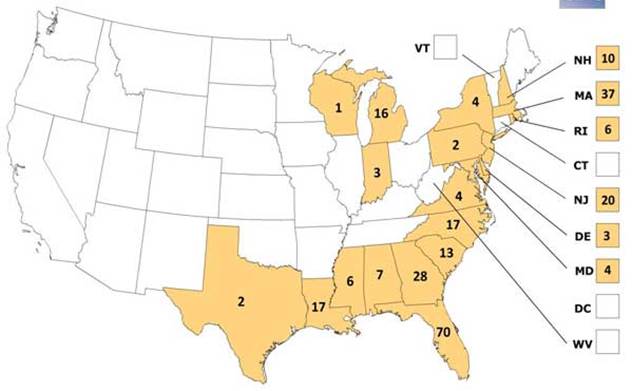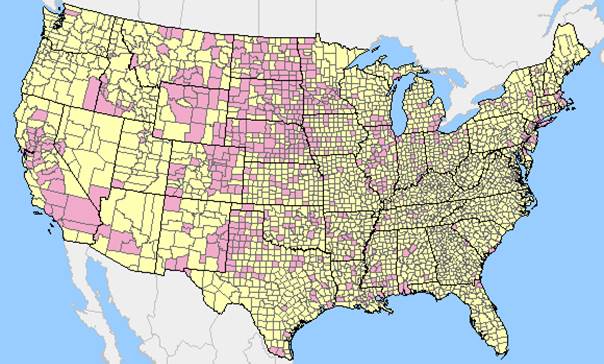Who is at risk for infection? (Disease Determinants)
RK: "Who" is at risk for infection makes me think that this page will be about human risk factors...but then there is a subsection about environmental conditions which is a little confusing.
Since EEE and WNV are arboviruses usually spread by mosquitos, both share similar disease determinants associated with the environment, personal behaviors, and physical characteristics of a person.
Environmental Conditions
The main environmental determinant for EEE and WNV is the amount of time spent in a region inhabited by infected mosquitoes. High-risk regions for WNV in the U.S. include Southern and Midwestern States (Figure 5). Freshwater hardwood swamps in Atlantic or Gulf Coast states are considered high-risk areas for EEE. States most affected by EEE include Florida, Georgia, Massachusetts and New Jersey (Figure 6). Other environmental factors that influence the likelihood of virus transmission include the presence of ideal mosquito breeding conditions like standing water or dense vegetation. Economic factors may also dictate the availability of community mosquito abatement programs that can significantly lower infection rates in specific areas.
Figure 5: Positive WNV test results (pink) compared to U.S. counties with no positive WNV results (yellow) reported for the 2012 surveillance cycle.
(http://diseasemaps.usgs.gov/wnv_us_human.html)

Figure 6: Number of Observed Cases of EEE by U.S. State from 1964-2010
(http://www.cdc.gov/easternequineencephalitis/images/eee_state_map_600px.jpg)
Personal Behaviors
Personal behaviors that increase the likelihood of mosquito exposure will increase the likelihood of disease development. The amount of time one spends outside and compliance with personal protective behaviors to limit acquisition of mosquito bites directly affect one's risk of disease. Also, actions to eliminate mosquito populations and insect breeding grounds on personal property are key to lowering personal risk of disease. Examples of recommended preventative actions include wearing long-sleeved clothing outside at times of peak mosquito activity and eliminating standing water in flower pots and roof gutters.
However, studies indicate that many individuals fail to observe recommended personal protective behaviors, despite having knowledge of the disease these behaviors protect against and having received information from a local or state health department. Some reports suggest that age is the most reliable predictor of failure to comply with personal protective behaviors.
For further reading on studies that analyze the uptake of personal protective behaviors for WNV:
http://www.ncbi.nlm.nih.gov/pubmed/18457290
Study on uptake of personal protective behaviors for WNV:
http://www.ncbi.nlm.nih.gov/pubmed/18457290
Physical characteristics
Physical characteristics like age and immune system health also play a role in the risk of disease transmission. Individuals below 15 years of age or above age 50 are most likely to become infected. However, severe symptoms, such as encephalitis and meningitis, are most likely to occur in individuals over the age of 50. Age may also influence practice of personal protective behaviors that significantly affect disease transmission.
Some investigators cite that children are greater risk for contracting WNV due to their typical higher levels of outdoor exposure, failure to avoid going outside and wearing long-sleeves compared to older populations. Other studies mention that older individuals (above 51 years of age) are less likely modify their daily actions such as wearing mosquito repellent containing DEET when outdoors and dawn or dusk.
Immunocompromised individuals such as HIV+ individuals or patients that have undergone recent chemotherapy or organ transplants are also at higher risk of infection. Serological surveys also indicate that a low prevalence of antibodies to WNV can be associated with areas of significant WNV transmission.
Study on increased WNV risk for children due to failure to observe personal protective behaviors:
http://www.ncbi.nlm.nih.gov/pubmed/17518307
Study that observes older adult's failure to wear mosquito repellent:
http://www.ncbi.nlm.nih.gov/pubmed/15850029
Serological studies for areas of intense WNV transmission:
http://www.ncbi.nlm.nih.gov/pubmed/17518307



